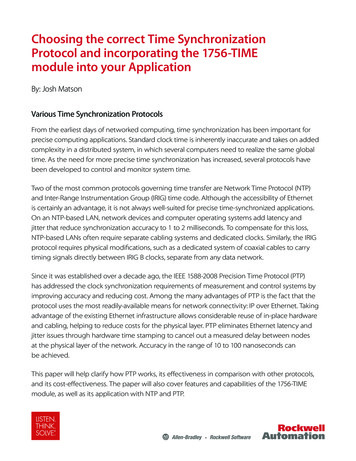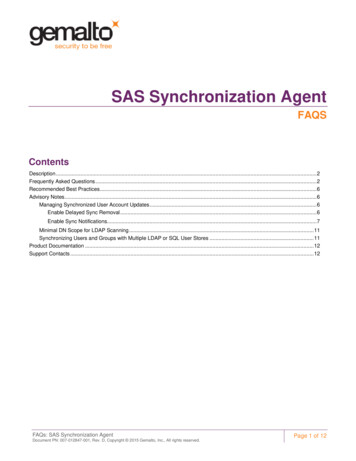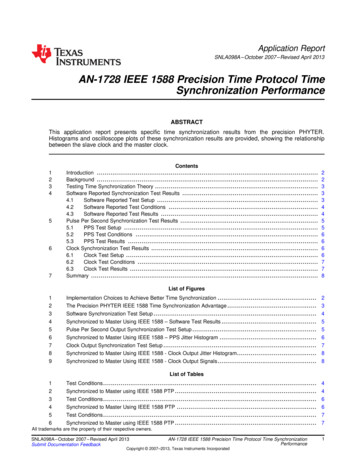
Transcription
Choosing the correct Time SynchronizationProtocol and incorporating the 1756-TIMEmodule into your ApplicationBy: Josh MatsonVarious Time Synchronization ProtocolsFrom the earliest days of networked computing, time synchronization has been important forprecise computing applications. Standard clock time is inherently inaccurate and takes on addedcomplexity in a distributed system, in which several computers need to realize the same globaltime. As the need for more precise time synchronization has increased, several protocols havebeen developed to control and monitor system time.Two of the most common protocols governing time transfer are Network Time Protocol (NTP)and Inter-Range Instrumentation Group (IRIG) time code. Although the accessibility of Ethernetis certainly an advantage, it is not always well-suited for precise time-synchronized applications.On an NTP-based LAN, network devices and computer operating systems add latency andjitter that reduce synchronization accuracy to 1 to 2 milliseconds. To compensate for this loss,NTP-based LANs often require separate cabling systems and dedicated clocks. Similarly, the IRIGprotocol requires physical modifications, such as a dedicated system of coaxial cables to carrytiming signals directly between IRIG B clocks, separate from any data network.Since it was established over a decade ago, the IEEE 1588-2008 Precision Time Protocol (PTP)has addressed the clock synchronization requirements of measurement and control systems byimproving accuracy and reducing cost. Among the many advantages of PTP is the fact that theprotocol uses the most readily-available means for network connectivity: IP over Ethernet. Takingadvantage of the existing Ethernet infrastructure allows considerable reuse of in-place hardwareand cabling, helping to reduce costs for the physical layer. PTP eliminates Ethernet latency andjitter issues through hardware time stamping to cancel out a measured delay between nodesat the physical layer of the network. Accuracy in the range of 10 to 100 nanoseconds canbe achieved.This paper will help clarify how PTP works, its effectiveness in comparison with other protocols,and its cost-effectiveness. The paper will also cover features and capabilities of the 1756-TIMEmodule, as well as its application with NTP and PTP.
2 Choosing the correct Time Synchronization Protocol and incorporating the 1756-TIME module into your ApplicationNTP vs. IRIG vs. PTPBecause it is ubiquitous, inexpensive, widely available, works well over LANs and WANs, andrequires little hardware, NTP has been the most commonly used protocol. However, dueto the use of switches and routers on LANs and WANs and the fact that many NTP clientsrun on non-real-time operating systems, such as Windows or Linux, NTP protocol accuracycannot be guaranteed (see chart, below right). On the Windows operating system, forinstance, clock corrections of 10-50 milliseconds are common, because the system is busyperforming tasks it deems more important than timekeeping.The IRIG protocol would seem to be a better choice, offering accuracy of up to 1–10microseconds. This time code is often used in precision timing-critical applications: military,aerospace, and power utility instrumentation. Because IRIG systems use dedicated coaxialtiming cabling between dedicated hardware clocks, the system has its disadvantages. Mostnotable of these disadvantages are the added expense of additional hardware and theincreased time skew due to the added physical infrastructure required.PTP, with its innate hardware-assisted time stamping, allows the user to take advantage ofthe NTP protocol’s cost-effectiveness by using existing Ethernet LANs, with accuracy betterthan that delivered by IRIG clocks. PTP can operate with normal Ethernet network traffic ona LAN with switches, while maintaining synchronization accuracy to the sub–microseconds.IEEE 1588 boundary clocks and transparent switches help achieve 20-100 nanosecondsynchronization accuracy.ProtocolMediaSync AccuracyNTPEthernet50-100 millisecondsIRIG-BCoaxial1-10 microsecondsPTPEthernet20-100 nanosecondsNetwork Time Protocol (NTP)Network Time Protocol (NTP) is used to synchronize time across an IP network. It utilizesport 123 as both the source and destination, and runs over the User Datagram Protocol(UDP). The NTP network generally uses a time source such as a radio or atomic clockattached to the main time server, then the NTP server distributes the time across thenetwork.No more than one NTP transaction per minute is necessary to achieve 1 millisecondsynchronization on a local-area network. For larger systems (wide-area networks), NTP canroutinely achieve 10 millisecond synchronization. However, the level of synchronization isnot guaranteed and can be affected by the infrastructure.An NTP enabled device never synchronizes to a device that is not synchronized itself.Additionally, an NTP enabled device compares the time reported by several NTP devices,and will not synchronize to a device whose time is significantly different than others.NTP has widely been deployed in enterprise level networks, and should be consideredwhen deploying plant-wide networks requiring synchronized time across multiple Cell/Area Zones. Because of the absence of PTP enabled network devices at the ManufacturingZone and higher, the implementation of NTP could be advantageous in the industrial
Choosing the correct Time Synchronization Protocol and incorporating the 1756-TIME module into your Application 3setting. If, for instance, a plant would like to piece together a sequence of events, it isnecessary to have a common understanding of time. At the Cell/Area Zone level it may stillbe best to implement PTP. However, at a higher level, there can be a greater number ofdevices supporting NTP.For more information about deploying Network Time Protocol,see this document.Simple Network Time Protocol (SNTP)Some devices only support Simple Network Time Protocol (SNTP), which is a simplified,client-only version of NTP. SNTP enabled devices cannot be used to provide time to otherdevices, they can only receive time from NTP servers. The SNTP enabled devices canachieve synchronization levels within 100 milliseconds.NTP Server ChoiceMany devices have the ability to be an NTP Server, plus there can also be multiple serverson the network. There are also publically accessible NTP servers, which you can learnabout by visiting NTP Pool Project.Most IT departments may have their own NTP server running internally, either on astandalone server, or within a switch or router. All clocks on the LAN can be synchronizedto that server. It is acceptable to utilize these existing NTP servers from the ManufacturingZone (Level 3) up through the Enterprise Network. Note: there is nothing built into the NTPprotocol to compensate for multiple hops through a large network. Therefore, the largerthe network, the larger the possible a time delay which may be introduced intoyour system.IRIG B-122 ProtocolIRIG time codes are another method of time synchronization used in the 1756-TIMEmodule. This module is the only Rockwell Automation product that supports the IRIGstandard. For this reason, we typically recommend using NTP or PTP when possible.IRIG also requires additional hardware and cabling, where as the other two methodsuse Ethernet. IRIG is used primarily when it is necessary to synchronize time acrosslarge geographic areas. To date, this system has been implemented primarily in largecommunication systems, data handling systems, missile and spacecraft tracking, and inlarge mining operations.Rockwell Automation uses the modulated IRIG B-122 implementation on the 1756-TIMEmodule for time synchronization. With this implementation, it is possible to achievesynchronization within one microsecond.Precision Time Protocol (PTP) – IEEE 1588-2008EtherNet/IP uses CIP Sync to synchronize device clocks on the Ethernet network.CIP Sync is the name given to time synchronization services for the Common IndustrialProtocol (CIP ). CIP Sync uses the IEEE 1588 “Standard for a Precision Clock SynchronizationProtocol for Networked Measurement and Control Systems,” referred to as Precision TimeProtocol (PTP), to synchronize devices to a very high degree of accuracy.
4 Choosing the correct Time Synchronization Protocol and incorporating the 1756-TIME module into your ApplicationThe IEEE 1588 standard specifies a protocol to synchronize independent clocks running onseparate nodes of a distributed control system to a high degree of accuracy and precision.The clocks communicate with each other over a communication network. In its basic form,the protocol is intended to be administration-free. The protocol generates a master-slaverelationship among the clocks in the system by determining which of the possible sourceshas the better accuracy. All clocks ultimately derive their time from a clock known as thegrandmaster clock.Once all the clocks in a control system share a synchronized, common understandingof system time, events being monitored in the control system (for example, theControlLogix system) can be time stamped to a very high degree of accuracy.For more information about Precision Time Protocol, see the Converged PlantwideEthernet Design and Implementation Guide, and Integrated Architecture and CIP SyncConfiguration and Application Technique.Example ArchitecturesIn our architecture, NTP is used to facilitate time management from Levels 3 through 5.The capability to do this may already be in place in existing Enterprise networks. BetweenLevels 3 and 2, a conversion from NTP to PTP takes place. This conversion will allow forNTP ServerEnterprise ZonesLevels 4 & 5ERP, EmailWide Area Network (WAN)Gbps Linkfor FailoverDetectionPatch ManagementTerminal ServicesApplication MirrorAV ServerIndustrial Demilitarized Zone (IDMZ)Firewall(Standby)CiscoASA 5500Firewall(Active)FactoryTalk Application Servers View Historian AssetCentre Transaction ManagerFactoryTalk Services Platform Directory Security/AuditData ServersCatalyst6500/4500RemoteAccess ServerIndustrial ZoneSite Operations and ControlLevel 3CiscoCatalyst SwitchNetwork Services DNS, DHCP, syslog server Network and Security MgmtCatalyst 3750StackWiseSwitch StackCell/Area ZonesLevels 0-2NTPNTP to PTPLogix5563EtherNet/IP FORCEHMIControllerHMIDriveLogix5563EtherNet/IP int oduleStatusNetworkActivityNetworkStatusPoint dPowerEtherNet/IP duleStatusPoint t BusStatusDriveSystemPowerFieldPowerI/OCell/Area Zone #1Redundant Star TopologyFlex Links ResiliencyControllerCell/Area Zone #2Ring TopologyResilient Ethernet Protocol (REP)Figure 1I/O1734-AENTSystemPowerFieldPowerI/OCell/Area Zone #3Bus/Star Topology
Choosing the correct Time Synchronization Protocol and incorporating the 1756-TIME module into your Application 5more accurate synchronization at the Cell/ Area Zone level. The plant-wide network willstill have similar clocks relative to each other, allowing for plant-wide Sequence of Eventsto take place. This architecture would be best fit for a plant where an existing NTP serveris in place, or for a plant where time synchronization between VLAN’s and subnets isnecessary, as PTP is not a routable protocol.For smaller architectures where an existing NTP server may not be present, and wherethere is only one subnet and VLAN, the following architecture would be appropriate. Inthis system the 1756-TIME module sits between the Cell/Area Zones and the rest of theplant. The TIME module acts as both the PTP Grandmaster for the entire VLAN/Subnet,as well as the NTP server for the rest of the plant. Since the clock on the TIME module willbe more accurate than that found on a computer, this system will have an overall moreaccurate clock. Again, it is important to note that this architecture is only appropriate forsystems with a single subnet and VLAN, as PTP is not routable.NTP ClientsEnterprise ZonesLevels 4 & 5ERP, EmailWide Area Network (WAN)Gbps Linkfor FailoverDetectionPatch ManagementTerminal ServicesApplication MirrorAV ServerIndustrial Demilitarized Zone (IDMZ)Firewall(Standby)CiscoASA 5500Firewall(Active)Catalyst6500/4500RemoteAccess ServerFactoryTalk Application Servers View Historian AssetCentre Transaction ManagerFactoryTalk Services Platform Directory Security/AuditData ServersIndustrial ZoneSite Operations and ControlLevel 3CiscoCatalyst SwitchNetwork Services DNS, DHCP, syslog server Network and Security MgmtCatalyst 3750StackWiseSwitch StackCell/Area ZonesLevels 0-2NTPPTP GrandmasterNTP ServerLogix5563EtherNet/IP FORCEHMIControllerHMIDriveLogix5563EtherNet/IP FORCEPTP nt oduleStatusNetworkActivityNetworkStatusPoint dPowerEtherNet/IP duleStatusPoint t BusStatusDriveSystemPowerFieldPowerI/OCell/Area Zone #1Redundant Star TopologyFlex Links ResiliencyControllerCell/Area Zone #2Ring TopologyResilient Ethernet Protocol (REP)Figure 2I/O1734-AENTSystemPowerFieldPowerI/OCell/Area Zone #3Bus/Star Topology
6 Choosing the correct Time Synchronization Protocol and incorporating the 1756-TIME module into your ApplicationUtilizing 1756-TIME Module NTP Client FunctionalityThus far, the discussion has been on achieving time synchronization across the plant floorby utilizing NTP. However, the NTP mechanism is not extremely accurate, so it may notalways be the best solution for all situations. For instance, at the Cell/Area Zone level, aCIP Motion system may be implemented. For CIP Motion, it is necessary to implementPTP, which requires a grandmaster. In order to still utilize the NTP time already propagatingthrough the plant, you have to convert NTP to PTP at the Cell/Area Zone level.As you can see in the following drawing, you can utilize the dual port embedded switchon the front of the 1756-TIME module as the conversion point for NTP to PTP.LED and LCDstatus informationNTP SourceEthernet Port 2Ethernet Port 1PTP GrandmasterGPS SMAConnectorIRIG-B CoaxialConnectorFigure 3 - 1756HP-TIME Module
Choosing the correct Time Synchronization Protocol and incorporating the 1756-TIME module into your Application 7This conversion can be achieved by utilizing the 1756-HPTIME module, along with its NTPClient capability. When configuring the HPTIME Module choose NTP as the source, ratherthan GPS. Then insert the NTP server IP address into the module. You can also force priorityfor CIP Sync Grandmastership from this tab.In order to bypass the GPS mechanism in the 1756-HPTIME module, it is necessary toput the module into “Simulation Mode,” which can be found in the Advanced Tab,as seen below:
Allen-Bradley, EtherNet/IP and LISTEN. THINK. SOLVE. are trademarks of Rockwell Automation, Inc.Trademarks not belonging to Rockwell Automation are property of their respective companies.Publication ENET-WP030A-EN-E – May 2013Copyright 2013 Rockwell Automation, Inc. All Rights Reserved. Printed in USA.
Network Time Protocol (NTP) is used to synchronize time across an IP network. It utilizes port 123 as both the source and destination, and runs over the User Datagram Protocol (UDP). The NTP network generally uses a time source such as a radio or atomic clock attached to the main time server, then the NTP server distributes the time across the










